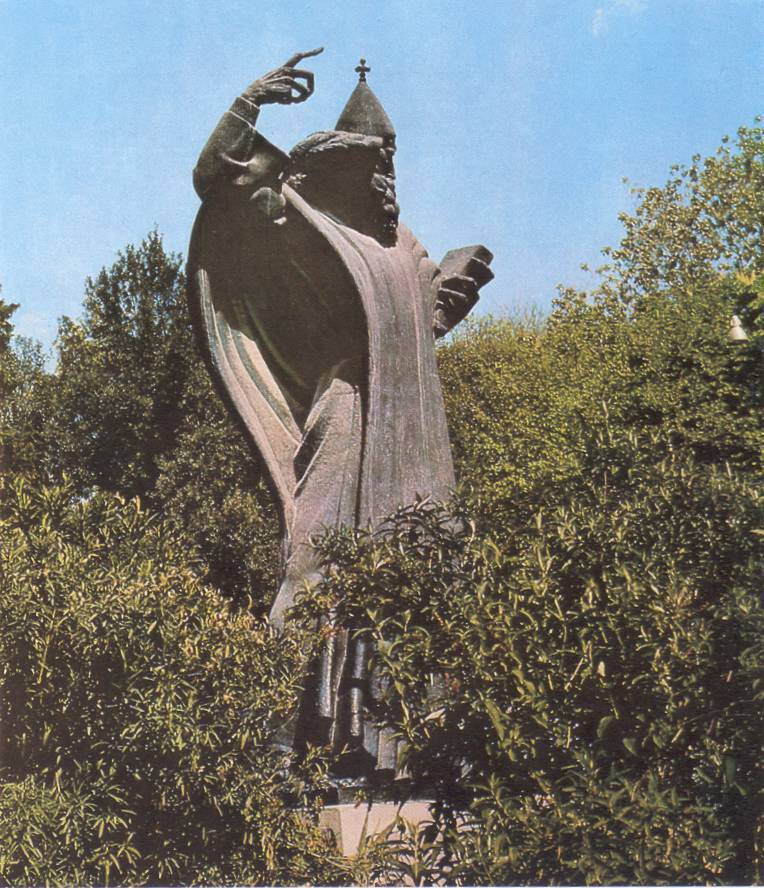

Tomislav (910 - 928)
Tomislav elevated Croatia to the highest sphere of European politics. Successfully repelling two foreign invasions in the 920s, Tomislav placed Croatia in a position of unprecedented power. During his reign he assumed sovereignty over the thema of Dalmatian towns; and advanced his title from that of prince to king - the first Croatian ruler to do so.
Tomislav succeeded Prince Muncimir following his death in 910 and was crowned at Duvno (today's Tomislavgrad in Bosnia Hercegovina).
In 925 Pope John X gave his blessing to Tomislav, as King of the Croats. In a well-preserved letter from this time, the Pope referred to the Croats as "most special sons" of the Holy Roman Church. Historians view these events as official international recognition of Croatia as a Kingdom and its subsequent inclusion in the highest tier of European diplomatic circles.
The rise of Tomislav attracted respect from many of his contemporaries. Byzantine Emperor Constantine Porphyrogenitus described Tomislav's Kingdom as a powerful state backed by substantial military capability. According to Porphyrogenitus' treatise on foreign affairs (De Administrando Imperio, chapters 29 - 31), Croatia possessed 60,000 cavalry, 100,000 infantry, 60 to 80 large ships and 100 smaller vessels. Quite a formidable force for the Middle Ages.

Eastern Gate and Cathedral, Split
Tomislav's rise coincided with the rapid expansion of the Bulgarian Empire under the powerful ruler, Symeon. Byzantium struggled in its resistance against the Bulgars and relied upon the Croats to threaten Symeon from the west. Croatia's military strength was put to the test when the Bulgars attacked in the 920s under the command of Alogobotur. The Croats ambushed the Bulgars in Bosnia and defeated Symeon's troops thus ending Bulgaria's expansion.
The Byzantine/Croatian alliance came at a price for Constantinople, which was pressured into ceding the Dalmatian urban areas under its administration to Tomislav. It should be noted however that the thema of Dalmatia in the 10th century was only a fraction of Dalmatia's current size. It included the urban areas (but not the hinterland) of Krk, Osor, Rab, Zadar, Trogir, Split, Dubrovnik, Kotor and Budva. Nevertheless, this was a momentous achievement which Tomislav's predecessors and Dalmatia's inhabitants had aspired to since the reign of Prince Trpimir (c.845 - 864).
Tomislav was also called to task by raids from Hungarians across his Kingdom's northern border into Slavonia. As with the Bulgars, these attacks were successfully repulsed in 924.
Following the consolidation of Slavonia with the Croatian littoral, the incorporation of the Dalmatian thema, and the successful resistance of foreign attack, Tomislav's Kingdom encompassed the territory of modern Croatia, Bosnia Herzegovina and the Montenegran coastline.
The last three years of Tomislav's rule were marked by a degree of internal and external quandary. Tomislav became entangled in a debate between the bishops of Nin and Split in which he rallied behind Bishop Grgur of Nin. The debate focused primarily on the use of the Croatian language and Glagolitic Script in liturgy. This quickly escalated into a dispute between pro Slavic and pro Latin clergy whereupon Tomislav requested Pope John X to send his envoys to Croatia to mediate. However, for the sake of uniformity within the Church, the Pope ruled immediately in favour of sustaining the use of Latin and censured those bishops who used Croatian. Pope Leo VI affirmed this ruling in 928.

Statue of Bishop Grgur in Split.
Following the death in 927 of the Bulgarian ruler Symeon, Byzantium no longer needed Croatia as an ally and began to reverse Tomislav's hard-earned sovereignty over the Dalmatian thema. Although the urban centres of the thema were wholly assimilated within Croatian political and cultural spheres, they reverted once again to Byzantine administration, albeit nominally.
It is not known whether Tomislav's rule ended due to ill health or other reasons. Despite the difficulty of his last three years in power, Tomislav is honoured along with Petar Kresimir IV (1058 - 1074) and Dmitar Zvonimir (1075 - 1089), as one of the greatest and most revered rulers of the early Croatian state.
Next (Trpimir II)
Copyright © Karl Baricevic. All rights reserved.